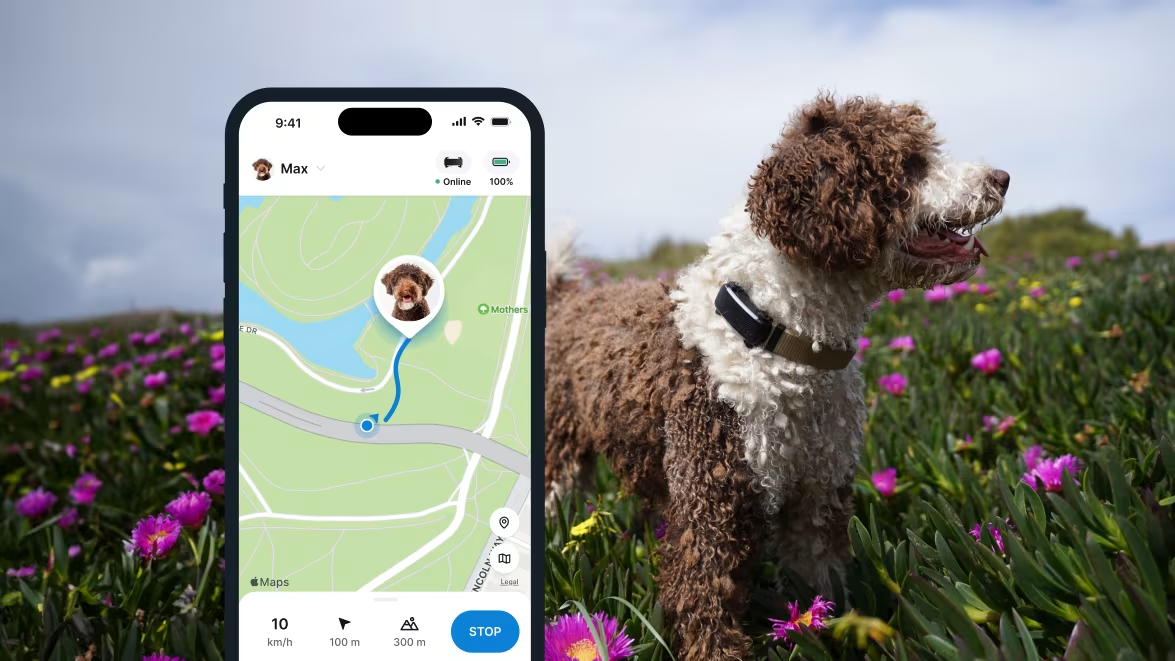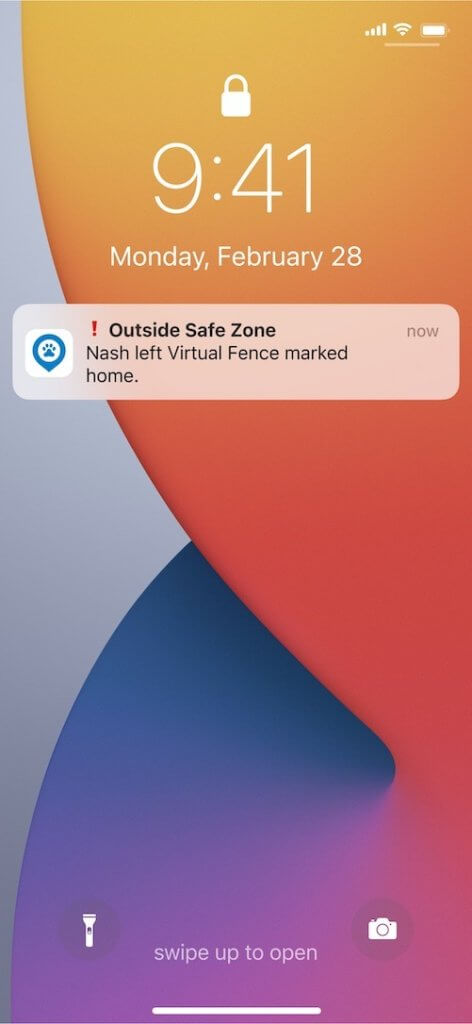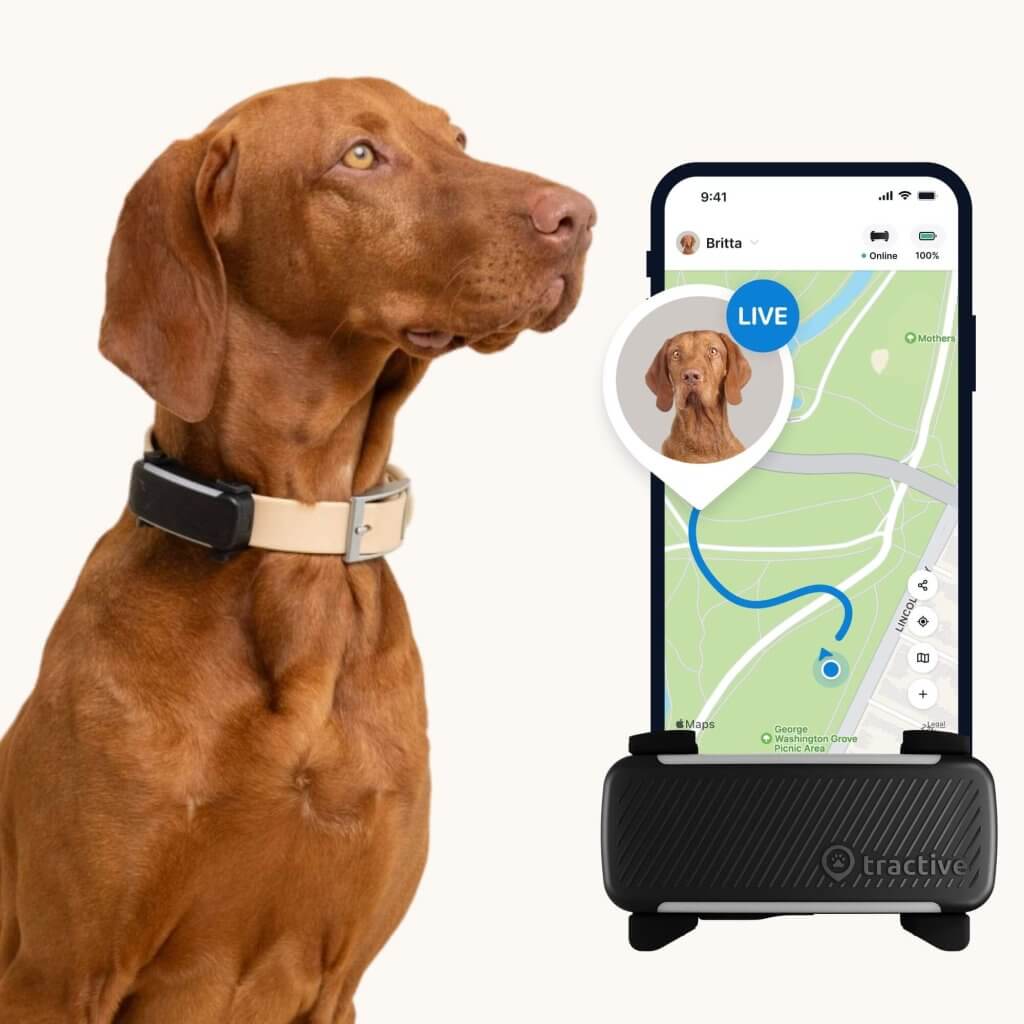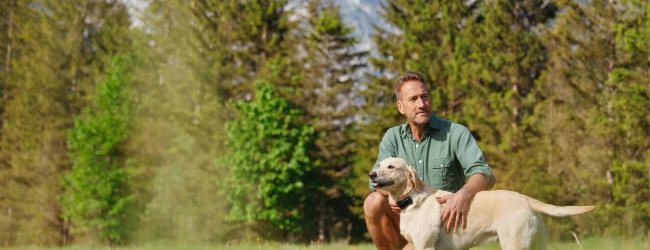Dog Recall: How To Teach Your Dog To Come When Called
Teaching your dog to come when called is one of the best ways to keep them safe outdoors. So here's how to get started with dog recall training - and what to do in an emergency, if your dog's dashed off too far to hear you.
Around 28% of dog parents in the US alone worry about their dog not coming back when calling their name.1 So in this post we’re going to cover how to teach your dog to come when called – and where a smart dog tracker can be a potential lifesaver if their runaway instincts override their training.
Key Takeaways
A reliable recall is essential for safety
Teaching a dog to come when called is one of the best ways to keep them safe outdoors, as they can easily get distracted and run off.
Use positive reinforcement
Keep your recall training sessions positive. Reward your dog with praise and treats and consider using a consistent sound like a clicker or a whistle.
Practice with consistency and patience
It’s important to keep training sessions short and regular and to be patient. You should also revisit the training periodically, as dogs can be unpredictable.
Use a smart dog tracker as an emergency measure
In case your dog runs off and doesn’t respond to your call, your Tractive devices tracks their location in real-time. Else, you could set up “Virtual Fences” to get escape alerts and have a crucial backup for their safety.

Always know your buddy is healthy & safe
Read moreHow a reliable dog recall keeps your buddy safe
Teaching a dog to come is one of the most reliable ways to keep them safe when you’re both outdoors. Even if you’ve kept your dog firmly leashed, it only takes a moment’s negligence for a hyperactive dog, a runaway dog breed, or an energetic puppy to bolt and dash off, miles away from safety.
⚠️ Around 45% of pet owners worry about their dog slipping out of their leash outdoors.2 Are you one of them?
Plus, if you haven’t trained your dog to return to you when you call out, say, “Max! Come!” – your buddy is more likely to end up running off too far for comfort. Where there’s no end to the dangers they might face. (From passing vehicles, fellow animals, or even being mistaken for a stray.) Even the best-trained dogs can fall prey to their own “flight” instinct. In these cases, their recall training can go out the window within seconds!
When can you start with dog recall training?
Vets recommend you get started with recall training as early as possible. So if you’ve just adopted a puppy, it’s best to train them to respond to commands like “Come!” and the sound of their name immediately. Just adopted an adult or senior dog? Now’s as good a time as any to revisit their recall training. (Or start from scratch, if necessary.)
In both cases: be prepared to invest time, patience, effort, and consistency. Senior dogs, for example, might suffer from hearing difficulties in their older years. So besides your voice, experiment with some other sounding devices (like high-frequency whistles) that they might hear more easily.
Read more: How To Train A Deaf Dog & Help Them Live Their Best Life
How to teach your dog to come when called
Help your dog learn that coming to you = pats & praise
Start simple in a familiar environment where they won’t be distracted easily. For example, you could walk around your home or backyard with one of your dog’s favorite toys. (Ideally, a noisy one.)
Get your dog’s attention by squeaking or shaking the toy. Don’t call out for them yet. Your dog might not respond immediately, but keep at it until they come to you. All the way to you – not just within sighting range! When they do come to you, reward your dog by patting them, praising them, or playing with them.
This helps your dog gradually learn that coming to you = a good thing that they should do every time.
With time, take a few more steps away. Squeak or shake the toy to get your dog to come to you from a slightly further distance. Now, whenever they come to you for their “reward”, start saying “Come!” Remember to keep your voice around the same pitch and tone (and ideally cheerful.)
Practice these steps regularly (and more frequently in the beginning) to help your dog improve their recall. With time, practice in different environments (like a nearby park) to help your dog build a more reliable recall. You could also combine recall training with a fun game like hide and seek. This helps your dog use their senses to find you behind a tree or even inside your house.5
Pick a consistent stimulus (or sound)
With time, do you necessarily need to always call out “Come!” to get your dog to return? Not really. In fact, your voice might vary depending on how much of a rush you are, whether you’ve got a cold, the wind and weather…you get it.
Which is where a sounding device like a clicker or whistle can come in handy over the long run. What’s important is to use this sound consistently throughout training. With time, it’ll become your “cue” for training your dog a specific behavior. I.e., the sound of the click (or your voice) = the prompt for a certain behavior = reward = good thing.
- So if you’re planning on vocalizing “Come!”, use more or less the same tone and pitch.
- Besides that, you could also use a whistle or a clicker that tend to make the same kind of noise, no matter where you use them. (So a bit more reliable than your voice.)
Use a harness, leash, or line during training
Vets recommend training your dog with a harness, leash, or long line in tandem. They can act as a “safety belt” if a high-energy puppy or active dog breed doesn’t respond immediately when you call out, “Come!”7 Just make sure not to pull your dog by their leash when you call them to return to you. (It’ll just make them resist.) Rather, if you use a long line instead, you can just step on it. This will help gently tug your running dog back in place.
Stay consistent with training
Dog recall training is all about consistency. And importantly: you want to ensure your dog doesn’t expect a treat every time they just come to you. (Rather, only when you call them, right?) So if your dog comes to you without you having called them, smile and interact with them. (Just don’t give them the treat or “reward” they’re used to.) But if they come to you when called, make sure to reward them consistently. Whether with a treat or an extra game of tug of war.
More recall training best practices
- Duration
Training sessions are always better off short and sweet – but also regular. Just 10-15 minutes a day can be enough to build a good habit. - Focus on one command a day
Any more and you might end up confusing your dog or giving them mixed signals. - Got a multi-dog household? It’s best to train them one at a time.
- Stay patient and don’t scold or yell at your dog if they don’t comply
You’ll just frighten your dog and make them less likely to follow your lead. - Combine your training sessions with some play time
So if you’re, say, leaving the room to teach your dog to come – your poor dog might just learn that “training = alone time!”
Revisit your dog’s recall training
Even the best-trained, most well-disciplined dog can fall prey to their own instincts. And even vets admit that no recall is perfect.8 So besides keeping your dog on a leash outdoors, make sure you periodically revisit their recall training. Which can help prevent them from running out on a street with passing vehicles – or bolting off into the woods after a woodland animal.
Plan ahead for an emergency
What if your dog has slipped out of their harness or you’ve lost control of their leash – and is now bounding down the road or forest path, too far away to hear the sound of your voice? Dogs run away for all sorts of reasons: curiosity, sniffing out a female in heat nearby, chasing down a woodland animal by instinct…and sometimes just plain boredom!
So besides recall training, make sure your dog is easy to identify with an ID tag, collar, and ideally, a microchip.
Where a smart dog tracker can be a lifesaver
With a smart dog tracker attached to your buddy’s collar, you can track down a running dog with just a glance at your phone. Using a Tractive device means you’ve now got a whole sky full of satellites helping you follow their every move in real-time and over an unlimited range once you’ve hit “LIVE” on your mobile app. Besides, unlike an AirTag, Tractive trackers don’t need a network of compatible devices to work. Plus, they work over an unlimited range.

From your mobile app, you could also set up a “safe zone” around a campsite or hiking trail or your home or backyard. Now if your dog ventures past it, you’ll get an instant escape alert to your phone.


It’s why dog parents around the world are investing in Tractive’s life-saving technology. (As an extra layer of security to their recall training.)
So when it comes to an excitable, easily-distracted puppy or a senior dog who might not even hear you calling for them…why leave things to chance?

Follow your dog anywhere
Get real-time location information, wherever they go. And find out when they try to make an escape, or just when they go somewhere they shouldn’t, with Virtual Fences.
And if you’ve liked this post, share it with a friend or loved one – and let’s build a safer, kinder world for our furry friends together.



